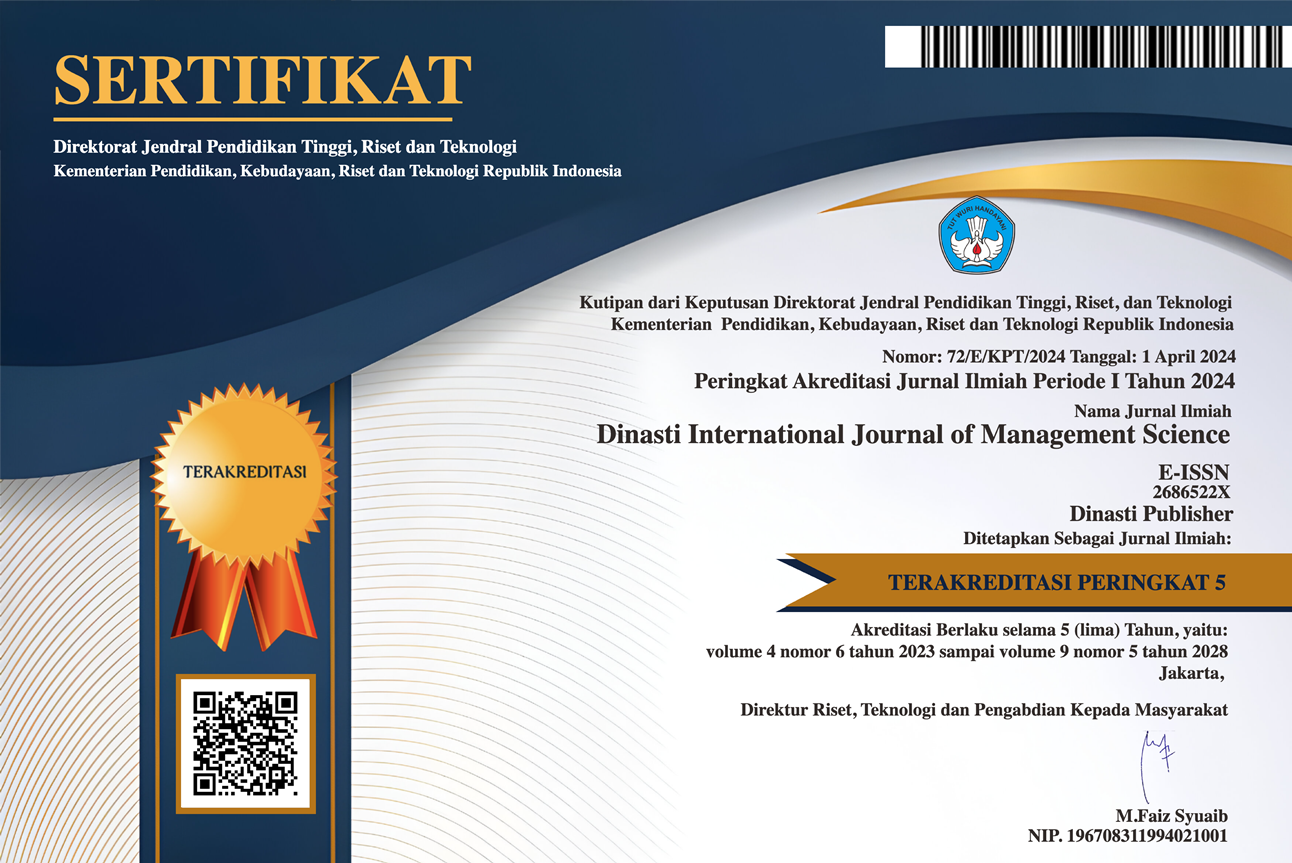Increasing training effectiveness through strengthening Instructor Competence, Training Design, Training Environment, Training Materials and Achievement Motivation
DOI:
https://doi.org/10.38035/dijms.v6i3.4144Keywords:
Training Effectiveness, Instructor Competence, Training Design, Training Environment, Training Materials, Achievement Motivation, SITOREMAbstract
This study aims to produce a strategy to improve the effectiveness of training through strengthening the variables of instructor competence, training design, training environment, training materials as independent variables and achievement motivation variables as intervening variables. A population of 685 resulted in 253 samples taken by proportional random sampling in 9 Fields of Expertise of Business and Tourism Vocational High School Teachers Participants in the BBPPMPV Business and Tourism Upskilling and Reskilling Training. This study used a survey method with a path analysis approach and SITOREM analysis. The results of this study can be concluded: 1) There is a significant positive direct effect between instructor competence, training design, training environment and achievement motivation on training effectiveness (Y); There is a significant positive direct effect between instructor competence, training design, training environment and training on achievement motivation; There is a significant positive indirect effect between instructor competence, training design, training environment and training materials on training effectiveness through achievement motivation. Achievement motivation cannot mediate instructor competence, training design, training environment on training effectiveness. The results of the SITOREM analysis show that the indicators that are still weak and need to be improved are: 1. interpersonal skills, 2. clarity of training objectives, 3. alignment of learning components, 4. learning support, 5. visual and interactive quality, 6. up-to-date and accuracy, 7. challenging objectives, 8. results orientation, 9. response to feedback, 10. learning support, 11. participant involvement, 12. learning, 13. reaction.
References
Adnan, N. A., & Khalid, S. A. (2021). The relationship between e-training, motivation and job performance during movement control order. Voice of Academia (VOA), 17(2), 186–198.
Ahmed, A., & Sayed, K. (2021). An extensive model for implementing competency?based training in technical and vocational education and training teacher training system for Assiut?Integrated Technical Education Cluster, Egypt. The Journal of Competency?Based Education, 6(2), e01245.
Athanassopoulos, A., Gounaris, S., & Stathakopoulos, V. (2018). Behavioural responses to customer satisfaction: an empirical study. European Journal of Marketing, 35(5/6), 687–707. https://doi.org/10.1108/03090560110388169
Awan, A. G., & Tahir, M. T. (2015). Impact of working environment on employee’s productivity: A case study of Banks and Insurance Companies in Pakistan. European Journal of Business and Management, 7(1), 329–345.
Beni, P. (2016). Konsep dan Analisis (Efektivitas Pengelolaan Keuangan Daerah di Era Otonomi Daerah). Jayapura: Taushia.
Billett, S. (2001). Learning through work: workplace affordances and individual engagement. Journal of workplace learning, 13(5), 209–214.
Billett, S. (2004). Workplace participatory practices: Conceptualising workplaces as learning environments. Journal of workplace learning, 16(6), 312–324.
Biswas, S., & Manna, B. (2018). Experimental and theoretical studies on the nonlinear characteristics of soil-pile systems under coupled vibrations. Journal of Geotechnical and Geoenvironmental Engineering, 144(3), 4018007.
Bohlander, G. W., & Snell, S. (2013). Principle of Human Resources. South-western Cengage Learning.
Bonneville-Roussy, A., Lavigne, G. L., & Vallerand, R. J. (2011). When passion leads to excellence: The case of musicians. Psychology of Music, 39(1), 123–138.
Brubacher, T. (2008). Beyond Good Intentions: Critical Race Theory and the Role of Non-indigenous Allies. Library and Archives Canada.
Burke, K. S., & Prieto, L. R. (2019). High-quality research training environments and undergraduate psychology students. Scholarship of Teaching and Learning in Psychology, 5(3), 223.
Chandrasekar, K. (2011). Workplace environment and its impact on organisational performance in public sector organisations. International journal of enterprise computing and business systems, 1(1), 1–19.
Cunningsworth, A. (2015). Choosing Your Coursebook. Heinemann Publishers Ltd.
Daft, R. L., & Lane, P. G. (2018). The leadership experience (Vol. 53). Cengage Learning Boston, MA.
Darmawan, D. (2017). Pengaruh Tekanan Peran Wirausaha dan Karakteristik Individu terhadap Efektivitas Kerja. Jurnal Media Informasi Ilmiah, No.59 Tahun IX Desember, 60–69.
Dick, W., Carey, L., & Carey, J. O. (2011). The systematic design of instructional (Vol. 7). Pearson Education, Inc.
Dubin, F., & Olshtain, E. (2012). Course design. Cambridge University Press.
EL Hajjar, S. T., & Alkhanaizi, M. S. (2018). Exploring the factors that affect employee training effectiveness: A case study in Bahrain. Sage Open, 8(2), 2158244018783033.
Evans, P., Shults, J., Weinberg, D. D., Napolitano, N., Ades, A., Johnston, L., Levit, O., Brei, B., Krick, J., & Sawyer, T. (2021). Intubation competence during neonatal fellowship training. Pediatrics, 148(1).
Fan, H. (2020). Factors affecting training effectiveness at Suning. com: an employees’ perspective. Ammattikorkeakoulujen opinnäytetyöt ja julkaisut.
Ford, J. K., Baldwin, T. T., & Prasad, J. (2018). Transfer of training: The known and the unknown. Annual review of organizational psychology and organizational behavior, 5(1), 201–225.
Gibson, J. L., Ivancevich, J., Donnnelly Jr., J., & Konopaske, R. (2012). Organizations: Behavior, Structure,Processes (14 ed.). McGraw-Hill.
Hammed, A. (2009). Introducing psychology of training in industry. An Unpublished Manuscript, Department of Guidance Counseling, University of Ibadan, Ibadan.
Haruna, H., & Marlina, S. (2019). Pengaruh Kompetensi Guru terhadap Prestasi Belajar Siswa pada Mata Pelajaran Ekonomi di SMA Negeri 5 Bone. Prosiding Seminar Nasional, 4(1).
Haynes, B. P. (2008). An evaluation of the impact of the office environment on productivity. Facilities, 26(5/6), 178–195.
Heinich, R. (2005). Application of systems concepts to instruction. American Annals of the Deaf, 603–616.
Hicks, A. U., Hewlett, K., Windle, V., Chernenko, G., Ploughman, M., Jolkkonen, J., Weiss, S., & Corbett, D. (2007). Enriched environment enhances transplanted subventricular zone stem cell migration and functional recovery after stroke. Neuroscience, 146(1), 31–40.
Hidayat, R., & Murniati, M. (2021). Achievement Of Student’s Learning Objectives Through Cooperation Of School Principles And Teachers In MTs Project Kandepag Medan. Almufida: Jurnal Ilmu-Ilmu Keislaman, 6(1), 1–12.
Ivancevich, J. M., Matteson, M. T., & Konopaske, R. (2008). Organizational behavior and management (Vol. 33). McGraw-Hill/Irwin.
Jonassen, D. (2014). Mindtools (Productivity and Learning). In Encyclopedia of Science Education (hal. 1–7). https://doi.org/10.1007/978-94-007-6165-0_57-1
Kajwang, B. (2022). Effects of training and development practices on performance of insurance sector in Kenya. International Journal of Research in Business and Social Science (2147-4478), 11(4), 140–148.
Kirkpatrick, J. D., & Kirkpatrick, W. K. (2016). Kirkpatrick’s four levels of training evaluation. Association for Talent Development.
Klein-Collins, R. (2013). Sharpening our focus on learning: The rise of competency-based approaches to degree completion. Occasional Paper, 20, 1–19.
Mahmudi. (2016). Manajemen Kinerja Sektor Publik. Yogyakarta: BPFE.
Mardiasmo. (2018). Akuntansi Sektor Publik (Mardiasmo, Ed.). Yogyakarta: Andi Offset.
Nafukho, F. M., Alfred, M., Chakraborty, M., Johnson, M., & Cherrstrom, C. A. (2017). Predicting workplace transfer of learning: A study of adult learners enrolled in a continuing professional education training program. European Journal of training and Development, 41(4), 327–353.
Noe, R. A. (2023). Employee Training and Development (6 ed.). McGraw-Hill Higher Education.
Noe, R. A., & Kodwani, A. D. (2017). Employee retention: A review of literature. International Journal of Management and Applied Science, 4(4), 29–34.
Oberauer, K., Awh, E., & Sutterer, D. W. (2017). The role of long-term memory in a test of visual working memory: Proactive facilitation but no proactive interference. Journal of Experimental Psychology: Learning, Memory, and Cognition, 43(1), 1.
Olowoselu, O., Amaru, A., Filonenko, K., Mbiine, R., Tuladhar, S., & Rondelli, D. (2019). Implementation and Evaluation of the First Global Blood & Marrow Transplantation (GlobalBMT) Training Program at the University of Illinois at Chicago (UIC). Biology of Blood and Marrow Transplantation, 25(3, Supplement), S322–S323. https://doi.org/10.1016/j.bbmt.2018.12.521
Patel, M. S., Reed, D. A., Smith, C., & Arora, V. M. (2015). Role-modeling cost-conscious care—a national evaluation of perceptions of faculty at teaching hospitals in the United States. Journal of general internal medicine, 30, 1294–1298.
Patrick, S. (2013). Mean what you say: Defining and integrating personalized, blended, and competency education.
Renshaw, I., Davids, K., Araújo, D., Lucas, A., Roberts, W. M., Newcombe, D. J., & Franks, B. (2019). Evaluating weaknesses of “perceptual-cognitive training” and “brain training” methods in sport: An ecological dynamics critique. Frontiers in psychology, 9, 2468.
Rivai, V., & Sagala, E. J. (2014). Manajemen Sumber Daya Manusia (2 ed.). Rajawali Pers.
Robbins, S. P., & Judge, T. A. (2008). Perilaku Organisasi (12 ed.). Salemba Empat.
Robin, J., & Burchell, M. J. (2013). No excuses: How you can turn any workplace into a great one. John Wiley & Sons.
Salami, S. O. (2008). Psychopathology and academic performance among Nigerian high school adolescents: The moderator effects of study behaviour, self-efficacy and motivation. Journal of Social Sciences, 16(2), 155–162.
Sao Joao, E. A., Spowart, J., & Taylor, A. (2019). Employee training contributes to service quality and therefore sustainability. Tourism and Leisure, 8, 1–15.
Sembiring, J. J. (2010). Smart hrd: Perusahaan tenang, karyawan senang. VisiMedia.
Setyaningsih, S. (2021). Penguatan Sumber Daya Manajemen Pendidikan Melalui Analisis Jalur ( Path Analysis ) & Metode SITOREM.
Shih, W.-C., Tseng, S.-S., & Yang, C.-T. (2008). Wiki-based rapid prototyping for teaching-material design in e-Learning grids. Computers & Education, 51(3), 1037–1057.
Sugiyono. (2015). Metode Penelitian Manajemen. Alfabeta.
Sutarto, J. (2017). Determinant factors of the effectiveness learning process and learning output of equivalent education. 3rd NFE Conference on Lifelong Learning (NFE 2016), 90–95.
Swanson, D. P., & Spencer, M. B. (2013). Competence formation: Resilience in educational contexts. In Urban Education (hal. 283–296). Routledge.
Swart, W., & Duncan, S. (2005). A methodology for assuring the quality of human performance. International Journal of Computer Integrated Manufacturing, 18(6), 487–497.
Temessek. (2009). Expanding the psychosocial work environment. Workplace Norms and Work-Family Conflict as Correlates of Stress and Health, 3(1), 71–88.
Tomlinson, B. (2023). Developing materials for language teaching. Bloomsbury Publishing.
Tran, L. T., & Nyland, C. (2013). Competency-based training, global skills mobility and the teaching of international students in vocational education and training. Journal of Vocational Education & Training, 65(1), 143–157.
Vallerand, R. J., Pelletier, L. G., Blais, M. R., Briere, N. M., Senecal, C., & Vallieres, E. F. (1992). The Academic Motivation Scale: A measure of intrinsic, extrinsic, and amotivation in education. Educational and psychological measurement, 52(4), 1003–1017.
Wahyudi, W., & Retnawati, H. (2014). Pengaruh Kepemimpinan Transformasional Kepala Sekolah, Pelaksanaan MBS, Dan Pelaksanaan TU Terhadap Kualitas Pendidikan SD/MI Depok Sleman. Jurnal Akuntabilitas Manajemen Pendidikan, 2(2), 250–264.
Wahyuningsih, S. (2019). Pengaruh Pelatihan Dalam Meningkatkan Produktivitas Kerja Karyawan. Warta Dharmawangsa, 13(2).
Wibowo. (2013). Manajemen Kinerja (3 ed.). PT RajaGrafindo Persada.
Downloads
Published
How to Cite
Issue
Section
License
Copyright (c) 2025 Wilia Ningsih, Sri Setyaningsih, Iyan Irdiyansyah

This work is licensed under a Creative Commons Attribution 4.0 International License.
Authors who publish their manuscripts in this journal agree to the following conditions:
- The copyright on each article belongs to the author(s).
- The author acknowledges that the Dinasti International Journal of Management Science (DIJMS) has the right to be the first to publish with a Creative Commons Attribution 4.0 International license (Attribution 4.0 International (CC BY 4.0).
- Authors can submit articles separately, arrange for the non-exclusive distribution of manuscripts that have been published in this journal into other versions (e.g., sent to the author's institutional repository, publication into books, etc.), by acknowledging that the manuscript has been published for the first time in the Dinasti International Journal of Management Science (DIJMS).
















































